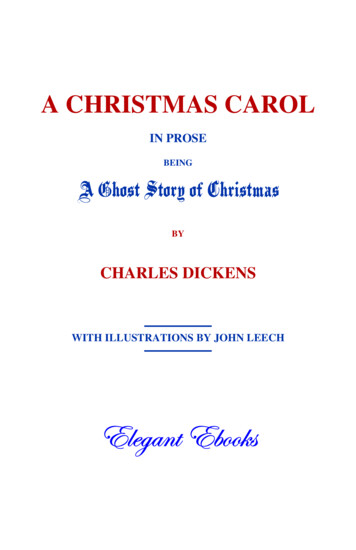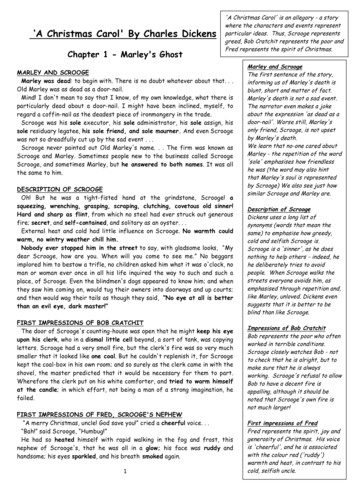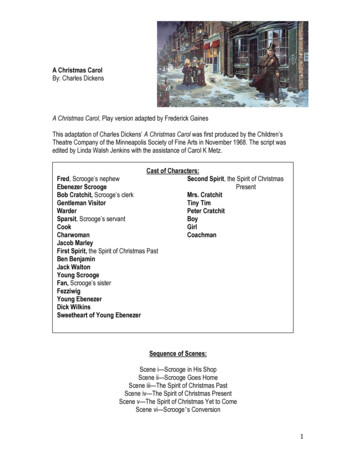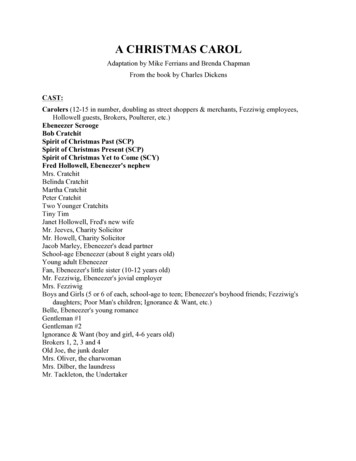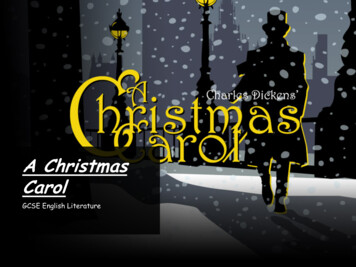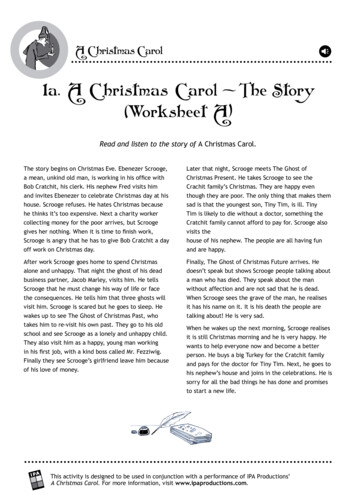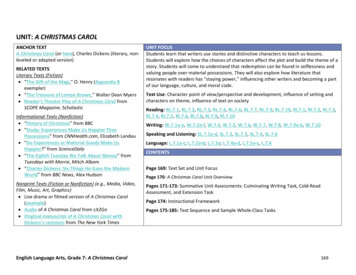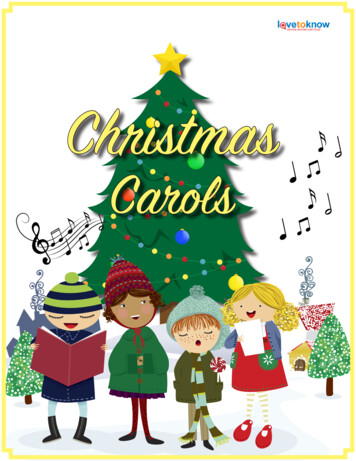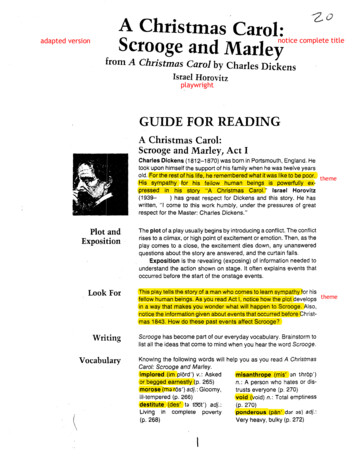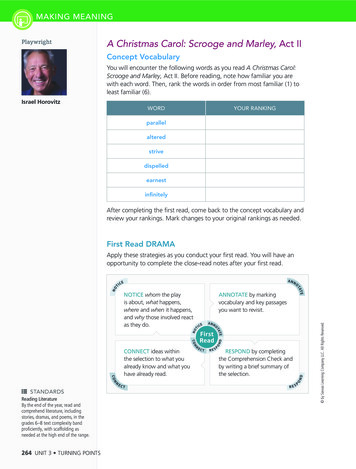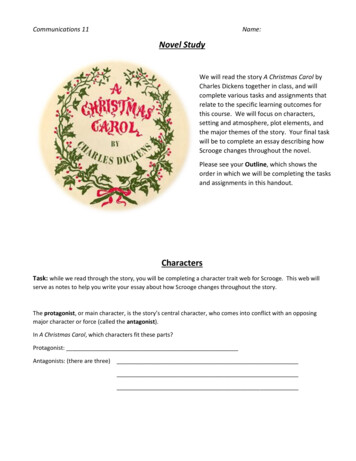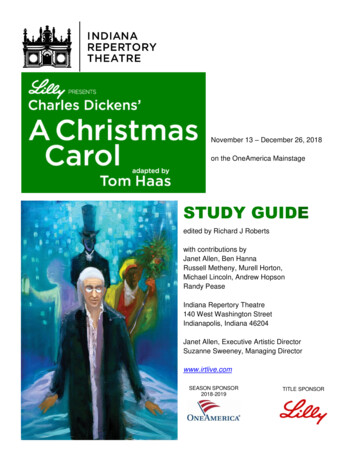
Transcription
November 13 – December 26, 2018on the OneAmerica MainstageSTUDY GUIDEedited by Richard J Robertswith contributions byJanet Allen, Ben HannaRussell Metheny, Murell Horton,Michael Lincoln, Andrew HopsonRandy PeaseIndiana Repertory Theatre140 West Washington StreetIndianapolis, Indiana 46204Janet Allen, Executive Artistic DirectorSuzanne Sweeney, Managing Directorwww.irtlive.comSEASON SPONSOR2018-2019TITLE SPONSOR
2INDIANA REPERTORY THEATRECHARLES DICKENS’A CHRISTMAS CAROL ADAPTED BY TOM HAASWhether you’re finishing a unit on Victorian literature, or just looking for a way to celebrate the end ofthe semester, A Christmas Carol returns once again to thrill and delight students of all ages. JoinEbenezer Scrooge, Tiny Tim and three lively ghosts on a dark, snowy journey that leads to a brightnew day of joy, hope and renewal. Filled with music and wonder, joy and redemption, the IRT’stimeless take on Dickens’ most memorable story will help banish your bah humbugs. Celebrate theseason with Indy’s favorite holiday tradition!Recommended for students in grades 4-12The performance will last 90 minutes with no intermission.STUDY GUIDE CONTENTSSynopsisAuthor Charles DickensA Christmas Carol on StageFrom the DesignersFrom the Artistic DirectorPlaywright Tom HaasDirector’s NoteMusic in the PlayVictorian LifeIndiana Academic StandardsResourcesDiscussion QuestionsWriting PromptsActivitiesGame: 20 QuestionsBritish Money in Scrooge’s DayText GlossaryGoing to the Theatre34681011121316181922242526293034COVER PAINTINGBY KYLE RAGSDALERobert Neal inA Christmas Carol, 2010.STUDENT MATINEES,ARTIST IN THE CLASSROOM,& YOUTH AUDITIONSSarah Geis 317-916-4841sgeis@irtlive.comCLASSES, YPIP, &SUMMER CONSERVATORYRandy D. Pease 317-916-4842rpease@irtlive.com
INDIANA REPERTORY THEATRETHE STORY OF3A CHRISTMAS CAROLA Christmas Carol tells the story of Ebenezer Scrooge, a bitter, miserly man, who is visited by fourghosts on Christmas Eve. The first ghost, Jacob Marley—Scrooge’s former business partner—visitsScrooge to warn him against his miserly and heartless ways. Marley tells Scrooge that if he doesn’tchange his selfish behavior and tend to the needs of his fellow man, he will be doomed to an afterlifeof misery. In order to redeem himself, Scrooge must accept the visitations of three spirits: the ghostsof Christmas Past, Present, and Future.The Ghost of Christmas Past shows Scrooge scenes from his childhood and early life. Along withsuch joyous events as a reunion with his sister and a lively holiday party, Scrooge relives manypainful memories—including the day he lost the woman he loved.The Ghost of Christmas Present shows Scrooge a range of Christmas gatherings. One is a livelycelebration hosted by Scrooge’s nephew, where the merry group plays a word game that mocksScrooge’s greed. Another is a modest Christmas dinner at the home of Scrooge’s employee, BobCratchit. The meal is meager but joyous, the only cloud being the illness of Cratchit’s son, Tiny Tim.Even Scrooge is touched by the boy’s bravery.The Ghost of Christmas Future shows Scrooge horrifying scenes of a dark, dismal future—vagrantslooting through a dead man’s stolen belongings, laughing and mocking the deceased; an un-mournedcorpse, left alone in an empty room—remnants of a life whose absence from the world is no greatloss, and to some a source of joy.Scrooge’s fate dependson his response to thespirits of Christmas Past,Present, and Future.The final moments of thestory radiate a spirit ofgenerosity andredemption, as well assheer, giddy joyousness,which have helped tomake A Christmas Carolone of the world’s mostpopular tales.The Cratchit family inA Christmas Carol, 2012
4INDIANA REPERTORY THEATREAUTHOR CHARLES DICKENSCharles Dickens, the great English novelist, was born February7, 1812, in Portsmouth, on the southern coast of England. Hisfather lost his job in the Naval Pay Office when Charles wasthree, and the family moved to London. The Dickens familymoved so often during Charles’s childhood that he was unableto attend school regularly.At the age of 12 Charles had to leave school to work in a ratinfested blacking (shoe polish) factory; two weeks later hisfather was sent to debtor’s prison. Luckily, a small inheritancerescued the family, permitting Charles to return to school fortwo years; but his formal education was short-lived. At 15 hebecame a legal clerk and at 18 a court reporter for the Mirror ofParliament and the True Son. Dickens quickly earned areputation as a top reporter.In 1834, Dickens began to publish short narrative sketches under the pseudonym “Boz” in theMorning Chronicle. Two years later he married Catherine Hogarth, daughter of a newspaper editor.Together, they had ten children before they divorced in 1858. Shortly after marrying Catherine,Dickens resigned from the newspaper and became editor of a new monthly magazine. This new joballowed Dickens more time to focus on his writing. He explored the difficult lives of pauper orphans inhis second novel, Oliver Twist.Although Dickens enjoyed great prosperity, the poverty of his youth left him suspicious of the rulingclass and sensitive to the plight of the downtrodden. His research on the notorious living conditions inlower-class boarding schools resulted in Nicholas Nickleby, in which a youth escapes from atyrannical schoolmaster.Dickens held strong views about the relationship between a lack of education and social oppression.He was giving a speech on education as the solution to England’s problems when he conceived theidea of A Christmas Carol. Shortly thereafter, in autumn 1843, he started writing the short book. Hecomposed it in a frenzy, alternately laughing and crying at the images that occurred to him; and hepolished it in his mind while walking the streets of London at night. With illustrations by Dickens’sfriend John Leech, the book was published at Christmastime 1843.Over the next few years, Dickens capitalized on the popularity of A Christmas Carol with several shortChristmas stories written in haste for quick reward. Dickens was obsessed with making a sufficientliving to support his large family, which included not only his ten children, but his and his wife’sparents and siblings. Much of Dickens’s writing was done for commercial purposes, which maysurprise those who consider Dickens a writer of mythic literary greatness.
INDIANA REPERTORY THEATRE5Dickens continued to incorporate his own life experiences into his works. David Copperfield, a semiautobiographical novel about a young man who struggles through poverty to achieve respect, was animmediate success in 1849. The novels Bleak House, Hard Times, and Little Dorrit followed in rapidsuccession. Their genesis followed a similar pattern: Dickens wrote chapters of each book forpublication in periodicals and later published them as complete novels. In this manner, the author wasliterally making up the story as he went along.Dickens spent the last years of his life traveling throughout the world to perform public readings fromhis novels. He was hailed everywhere as the greatest writer of his age. Although he enjoyed travelingand exhibiting his acting skill, it was strenuous work. In June 1870 he suffered a stroke and diedinstantly at the age of 58. For three days, thousands of citizens passed by his open casket inWestminster Abbey, paying their respects to this most beloved of English writers.DICKENS AND THE VICTORIAN CHRISTMASDuring the nineteenth century, as England became less rural and more industrial, old Christmascustoms were lost. In A Christmas Carol, written and published in 1843, Charles Dickens found a wayto both celebrate and revitalize old country holiday traditions by transplanting them to an urbansetting.As Scrooge revisited his childhood, readers were reminded of their own childhood celebrations, orthose they had heard about from their parents and grandparents. When Scrooge journeyed with theSpirit of Christmas Present, readers encountered lavish and lengthy descriptions of a wide variety ofholiday celebrations, from the humblest to the most luxurious. In reality, such Christmas revelry waslargely a product of Dickens’s imagination. But A Christmas Carol, along with Dickens’s otherChristmas stories, enjoyed a wide audience, andthese tales inspired readers as they prepared theirown holiday celebrations.Dickens was not alone in revitalizing the holiday.The same year A Christmas Carol was published,the first Christmas card was printed, and three yearslater Prince Albert, Queen Victoria’s husband,introduced the German Christmas tree to England.But it was Dickens who became so synonymouswith Christmas that, when he died in 1870, a little girlin London asked, “Mr. Dickens dead? Then willFather Christmas die too?”The Fezziwigs by Dickens’s original illustrator,John Leech.
6INDIANA REPERTORY THEATREA CHRISTMAS CAROL ON STAGEA Christmas Carol, like all of Charles Dickens’s novels, contains a panorama of places andcharacters brilliantly described by a masterful storyteller. Bringing a novel to the stage is achallenge—the novel is primarily a narrative form and the theatre is a forum for action and dialogue—but it is a challenge the IRT embraces. Stage adaptations of novels recently produced by the IRTinclude The Curious Incident of the Dog in the Night-Time, The Cay, The Three Musketeers, To Kill aMockingbird, The Great Gatsby, The Hound of the Baskervilles, The Giver, The Velveteen Rabbit, AnIliad, Dr. Jekyll and Mr. Hyde, and Around the World in 80 Days, not to mention our upcomingproduction of the non-fiction classic The Diary of Anne Frank.The richness of Dickens’s prose makes the task of adaptation to the stage especially daunting. TheIRT’s adaptation of A Christmas Carol uses Dickens’s language not only as dialogue, but also asnarrative, so we experience the story much as the author wrote it. This technique allows the audienceto hear the original language of the novel, where Dickens makes meaning not only through story, butalso through his choice of rhythms, sounds, metaphors, and dialects. This uniquely theatrical way oftelling a story is a celebration of the craft of the actor and the power of the audience’s imagination.The IRT’s adaptation of Dickens’s novella was written by former IRT artistic director Tom Haas andproduced at the IRT every year from 1980 through 1984. After a twelve-year hiatus, the play wasbrought back in 1996 and is now making its 28th appearance.Ben Tebbe andRyan Artzberger inA Christmas Carol,2011. The snow ismade of shreddedplastic. Each 25pound box of“snow” covers a 7by-7-foot square.To cover the entirestage requires 23boxes of “snow,” or575 pounds.During the full runof A ChristmasCarol, the IRT usesabout 40 boxes, or1,000 pounds total.That’s half a ton ofsnow!
INDIANA REPERTORY THEATRE7The IRT production of A Christmas Carol varies from year to year, but always features Dickens’swonderful storytelling, presented by actors who play several roles. This year’s production will bedirected for the first time by the IRT’s associate artistic director, Benjamin Hanne, who last seasondirected The Town Mouse and the Country Mouse. Later this season he directs Elephant & Piggie’s“We Are in a Play!”As for the cast, some will return from previous years, some will be new, and some will be returningbut in new roles. Ryan Artzberger, who has played many different roles in the Carol over the years,will play Scrooge for the ninth time. Lighting designer Michael Lincoln will fine-tune his special lightingeffects. The production continues to use music by composer Andrew Hopson. Every year MurrellHorton’s elaborate period costumes must be refit or rebuilt to suit a new company of actors; thisseason, as the last two years, the Ghost of Christmas Present will be played by a woman (MilicentWright, below), which has called for some costume modification.One thing that will not change this year is the snow. Audiences and actors alike delight in thisproduction’s endless snow-covered field, first envisioned by scenic designer Russell Metheny. Duringthe performance actors make tracks through the snow, suggesting their individual journeys. Hiddenobjects and trap doors under the snow add to the mystery and spirit of this production. With the stagemasking stripped away, the theatre’s backstage area is revealed, allowing the audience to experiencethe magic of the story while seeing how it is created.A Christmas Carol brings to mind visions of Christmascheer and scenes of a distant past in which we wishwe could participate: a merry gathering at theChristmas dinner table with roast goose and asteaming plum pudding; a lively dance of country folkon Christmas Eve; a family toast in which a poor boycalls forth the spirit of Christmas with a simple, “Godbless us, everyone!” These impressions of AChristmas Carol are the essence of its lingering charmand create moments of celebration in the theatre. TheIRT’s production will be filled with such visions andmuch more; for these visions can inspire a spirit ofgenerosity and goodwill that we need not only at theholiday season, but all the year through.Milicent Wright asthe Ghost of Christmas Present inA Christmas Carol, 2017.
8INDIANA REPERTORY THEATRE“THE MERRIEST TIME IN ALL THE WORLD”RUSSELL METHENYSCENIC DESIGNERIt’s ironic, but as a scenic designer thething I love most is greatperformances. I love creating anempty space in which greatperformances happen. That’s whatthis set is all about: an empty field ofsnow in which wonderful actors tell awonderful story. When I seesomething on stage that is not what itis and looks like something else—thatto me is great theatre.Preliminary sketch for Scrooge’s officeby scenic designer Russell Metheny.MICHAEL LINCOLNLIGHTING DESIGNERWell of course, the first thing is thesnow. That enormous field of whiteoffers a technical challenge to alighting designer. It’s harder to createisolated lighting effects; everything justbounces all over the place. But I alsohave unique opportunities, such ascreating silhouettes against the snow.In terms of design, the snow functionsvery much like a sky drop—it’s a blankcanvas on which I can paint any color.This production does not rely ontheatrical “effects.” It’s all about themagic created between the actors andthe audience. There are always newdiscoveries to make in the snow. It’san unnerving yet exhilarating process.
INDIANA REPERTORY THEATREMURELL HORTONCOSTUME DESIGNEROne of the original goals for this design was tocreate costumes authentic to the period, basedon real Victorian clothing rather than fancifulideas of nostalgia. The clothes for this period(1840s) are industrial—top hats were called stovepipes—and dark, with sharp silhouettes againstthe beautiful snow (which is so white it makes itsown set of rules). But the play also ventures intothe past, which has a more dreamy, foggy,candlelit look; and into the future, which is darkerand creepierPreliminary sketches for(up left) Fred, (up right) the Charwoman,(lower left) the Undertaker,& (lower right) the Lamplighterby costume designer Murell Horton.ANDREW HOPSONCOMPOSERThe pipe organ has thedistinction of being associatedwith three diverse concepts:religion, theatre, and phantoms.Using an organ as one of themain instruments in AChristmas Carol was anobvious choice. For ghostlysound effects, I ended up usingfour metal instruments: forMarley, I used a waterphone(an instrument invented—Ithink—for the movie Aliens); forChristmas Past, I used windchimes: for Christmas Present,I experimented with harpstrings; for Christmas Future, Iplayed a cymbal with a violinbow, and dragged a chaininside a piano.9
10INDIANA REPERTORY THEATREREMINDERSby Janet Allen,Executive Artistic DirectorHave you ever wondered why A Christmas Carol continues to bring so much joy to so many, despitethe many strands of unfortunate events contained in the tale? Dickens knew more than a little abouthuman nature. He knew that some of the best lessons in living come after we go through darknessand learn to appreciate life anew. His tale dramatizes a maxim that we often forget: money doesn’tbuy happiness. The Cratchits, despite their economic struggles, are “happy, grateful, pleased withone another, and contented with the time.” Scrooge, for all his wealth, is “a wrenching, grasping,scraping, clutching, covetous old sinner; hard and sharp as flint, from which no steel had ever struckout generous fire.” Although most of the time we’re too consumed by our own challenges to really seeour lives with much clarity, theatre is an excellent place to experience allegory. Somehow, we cantranspose its lessons into our own lives.The company of A Christmas Carol, 2017
INDIANA REPERTORY THEATRE11We seem to be at no loss today for continuous public displays of what’s worst about human nature.Finding something we can all celebrate about humanity seems to elude us. Dickens, too, was living ina time of great change and unrest. The Industrial Revolution was rather like our Tech Revolution inthe speed at which change was jarring people into the kind of freefall that can unhinge humans fromremembering their best selves. At times like these, great writers gravitate to telling timeless stories:stories that focus on generosity, on the need for human connection, on the importance of seeing andhelping others.Scrooge lives in self-imposed isolation: he does not experience his humanity at all except as an act ofsurvival. The spectral journey that Dickens launches Scrooge into is meant to jar him back into touchwith his humanity by reminding him of what he’s lost: his attachment to nature, to other people, to thejoys of love. He needs very serious reminding.Perhaps we all need reminders in this festive season. Reminders that it is the season of giving, nottaking; the season of looking around ourselves to see how we can reach out, how we can be ofservice, how we can experience our humanity anew. Thanks, Mr. Dickens, for handing us thisrenewing lesson across 170 years. Perhaps you knew that we were still going to need it.PLAYWRIGHT TOM HAASTom Haas was artistic director of the IRT from 1980 untilhis untimely death in 1991. Prior to his association withthe IRT, he was artistic director of PlayMakers RepertoryCompany in Chapel Hill, North Carolina. He wasassociate director at Yale Repertory Theatre and head ofthe Acting-Directing Program at Yale University, wherehis students included Henry Winkler, Sigourney Weaver,and Meryl Streep. At the IRT, Tom directed 40productions, including memorable renditions of AMidsummer Night’s Dream, Mourning Becomes Electra,The Skin of Our Teeth, The Cocktail Party, SixCharacters in Search of an Author, and, of course, AChristmas Carol. IRT audiences also saw his stageadaptations of Frankenstein, Dracula, and The ThreeMusketeers, as well as the musical Operetta, My DearWatson and dozens of Cabaret shows. Tom’s adaptationof A Christmas Carol was produced at the IRT annuallyfrom 1980 through 1984. The play returned in 1996 andhas been a holiday tradition ever since.
12INDIANA REPERTORY THEATRESTRONGER TOGETHERBY BENJAMIN HANNA, DIRECTORToday will likely not be your first encounter with Ebenezer Scrooge. The haunting ghost story of acrooked, isolated miser turned celebrated humanitarian and philanthropist has been told across theglobe for more than 170 years. Perhaps you were introduced by Kermit in the Muppets’ retelling, or ashadowy black and white movie from your youth, or maybe you were lucky enough to have a lovedone read Charles Dickens’s incredible tale to you, nestled by a fire.Dickensian life seems so far from the world we live in today. After all our advances in socio-politicalreform, healthcare, research, and technology, it is hard to imagine how incredibly comparable theworlds are that we inhabit, particularly in relation to wealth. For some 30 years in America we haveseen the gap between the rich and everyone else growing markedly by every major statisticalmeasure, the bulk of wealth amassed in the hands of just 1% of the population. We continue to sufferfrom the fantasy of the self-made person; one who picks themselves up by their own bootstraps andsucceeds without the help of others. The reality is that each of us have been dealt a very specifichand in life, and the contents of that dealing, without aid from those who can spare it, can and doesstrongly influence our trajectory.Now more than ever, A Christmas Carol is a story we need. We live in a polarized time, unable to seethe humanity of our neighbors beyond their political viewpoints. Increasingly, we find it difficult toempathize with those in need, to listen deeply to the stories of new Americans, and to open ourhearts to those who are different from us. Our communities—diverse in age, race, ethnicity, gender,ability, religion, sexuality, culture—need the ghosts of past, present, and future to guide us. Thesespecters help us celebrate the fact that with each new breath we are given the opportunity to change.Every year in the longest, darkest, most frigid days of our calendars, we gather in the theatre to studyour own hearts in hopes of doing better for each other and growing stronger together. We hope youleave filled with the spirit of the season and a renewed sense of joy in sharing your blessings!The Cratchitfamily in AChristmasCarol, 2016
INDIANA REPERTORY THEATRE13CAROLS OF THE CAROLThe complete title of Dickens’s book, as printed on the title page of the first edition, is A ChristmasCarol in Prose (as opposed to the usual sung carol, which would be written in verse). Dickensextended the song metaphor by calling each chapter a “Stave,” an archaic term for staff or stanza. Anumber of traditional holiday songs are heard in the IRT’s production of A Christmas Carol.“IN THE BLEAK MIDWINTER”The poem “In the Bleak Midwinter” was written some time before 1872 byEnglish poet Christina Rossetti (1830-1894), sister of Pre-Raphaelitepainter Dante Gabriel Rossetti (1828-1882), who often used her as amodel. English composer Gustav Holst (1874-1934) wrote a hymn tune forthe poem that first appeared in The English Hymnal in 1906.Poet Christina Rossetti painted by her brother Dante Gabriel Rossetti.“GOD REST YE MERRY, GENTLEMEN”The sense of this song is not “God rest ye, merry gentlemen,” but “God rest ye merry, gentlemen.”“God rest ye merry” was an old greeting, meaning literally, “sleep well,” and more generally, “MayGod keep you well.” The origins of this song go back to the 15th or 16th century. Some believe that itwas a hymn of protest against the banning of Christmas in England in the 1640s, when England’sPuritan government saw Christmas as a pagan holiday that defiled Christianity. It is thought that thesong was sung outside places where people were imprisoned for celebrating Christmas. This historymight also explain the music’s minor key, which is unusual among Christmas songs.“DECK THE HALL”“Deck the Hall” is a traditional Welsh carol. The melody dates back to the 16th century, when it wasknown as “Nos Galan” (New Year’s Eve). The English lyrics were written by Scottish musicianThomas Oliphant in 1862. It is thought that thiscarol may have developed from the Welsh canupenillion tradition, in which dancers moved in aring around a harpist. Originally, the dancerswould sing the verses and the harpist would playthe “answering bars” (Fa la la la la, etc.), butnonsense syllables were substituted when therewas no harpist. Many Renaissance madrigals ofthis era feature fa la la sections. The word “hall”in the title refers not to (plural) corridors orhallways, but rather to a (singular) great hall, thelargest room in a castle or manor house.
14INDIANA REPERTORY THEATRE“TOMORROW SHALL BE MY DANCING DAY”“Tomorrow Shall Be My Dancing Day” is a traditional English carol. The word carol derives from theFrench carole or the Latin carula, meaning a circular dance. Old carols that were written in threequarter time were written as crèche dances, to be sung as people danced around the crèche ormanger. The verses of “TomorrowShall Be My Dancing Day”progress through the story of thelife of Jesus told in his own voice.“My dancing day” refers to the dayof Jesus’s birth; throughout thecarol, his life is repeatedlycharacterized as a dance. “Mylove” and “my true love” arereferences to the church, which iscalled the bride of Christ in manyChristian writings.“Tomorrow Shall BeMy Dancing Day”—the 2015 IRT cast ofA Christmas Carol.THE “COVENTRY CAROL”The “Coventry Carol” dates from the 16th century. It was traditionally performed in Coventry, England,as part of The Pageant of the Shearmen and Tailors, a medieval Nativity play. The song refers to theBiblical story of King Herod, who feels threatened by a prophecy of a newborn king and orders allmale infants in Bethlehem to be killed. The song is a lullaby sung by mothers of the doomed children.“I SAW THREE SHIPS”“I Saw Three Ships” is a traditional Englishcarol; the earliest printed version is from the 17thcentury. The lyrics mention the ships sailing intoBethlehem, but the body of water nearest toBethlehem is the Dead Sea, about 20 miles away.The reference may originate in the three ships thatbore the purported relics of the three Magi toCologne Cathedral in the 12th century. Anotherpossibility is that the ships are actually the camelsridden by the Magi, as camels are frequentlyreferred to as “ships of the desert.”
INDIANA REPERTORY THEATRE15“CAROL OF THE BELLS”“Carol of the Bells” is based ona Ukrainian New Year’s carol,arranged in 1916by composer and teacherMykola Leontovych (18771921). The Ukrainian song,which tells of a swallow flyinginto a home to herald abountiful new year, wasinspired by a traditional folkchant whose language wasthought to have magicalproperties. The song wasintroduced to Americanaudiences by the UkrainianNational Chorus at CarnegieHall in 1921. American composer and choral conductor Peter J. Wilhousky (1902-1978), who wasfrom a Ukrainian family, attended that concert; he later arranged the song as “Carol of the Bells” andpublished it in 1936. Wilhousky wrote new lyrics centered around the theme of bells because themelody reminded him of hand bells.“HERE WE COME A-WASSAILING””Here We Come a-Wassailing” is a traditional English Christmas carol and New Year song thought tohave originated in the mid-19th century. The “a-” is an archaic intensifying prefix, such as seen in thelyrics to The Twelve Days of Christmas (“Seven swans a-swimming,” etc.). Wassail is a punch madeof wine, beer, or cider mixed with sugar, spices, and baked apples. It is served hot in a very largebowl—the wassail bowl. The word“wassail” is derived from the MiddleEnglish “wass-heil”—a greeting thatmeant “be of good health.” To gowassailing is to go from door todoor singing carols; hosts whoreceive such visitors may choose totreat them to something warm andcomforting, such as wassail.
16INDIANA REPERTORY THEATREWHY DID THEY SAY THAT?VICTORIAN LIFE AS SEEN IN A CHRISTMAS CAROLCharles Dickens wrote A Christmas Carol in 1843, early in the Victorian Era (named after QueenVictoria, who reined in the United Kingdom from 1837 to 1901). Life and social customs in this timediffered greatly from today, as seen in the following quotes from the Carol.“WHY DID YOU GET MARRIED?”Victorian economists did not approve of those who married before they had sufficient income tosupport a family. To marry for love was a fairly new idea, and thought to be sentimental nonsense.Arranged marriages for economic benefit were still the norm.“YOU’LL WANT ALL DAY TOMORROW, I SUPPOSE.”At this time, it was not uncommon for businesses such as shops and factories to operate as usual onChristmas Day.“OUR CONTRACT IS AN OLD ONE.”Marriage in Dickens’s time was based more on economic arrangements than romantic interests. A“respectable” woman could not work for a living; therefore, if her father could not support her for life,she had no choice but to marry a man who could. Until the early 20th century, a man’s promise ofengagement was considered a legally binding contract. If the man were to break the engagement, thewoman’s reputation might be damaged, making it difficult or even impossible for her to find a husbandto support her. The abandoned woman could therefore take him to court and sue him for “breach ofpromise.” It was veryunusual for a woman tobreak an engagement;Belle’s decision to do soputs her in a precarioussituation, as she has nofamily income to fallback upon.Ashley Scallon,Matthew Brumlow, andRyan Artzberger in AChristmas Carol, 2012.
INDIANA REPERTORY THEATRE17“OUTSIDE THE BAKER’S THEY HAD SMELT THE GOOSE,AND KNOWN IT FOR THEIR OWN.”Bakeries were forbidden by law from baking bread on Sundays and holidays. Since poor familiesusually had no stoves, they could take their dinner to the bakeshops on such occasions and have onehot meal a week. The young Cratchits claim to have identified their own goose from all the mealscooking at the local bakery.“ TO THE WASHHOUSE, THAT HE MIGHT HEAR THE PUDDINGSINGING IN THE COPPER.”The English Christmas pudding is not like our modern,creamy pudding; it is more like a bread pudding. Flour,milk, and eggs are often combined with dates, plums,figs, and/or nuts. (There are numerous references toplum pudding or figgy pudding at Christmastime.) Thebatter is placed in a lidded tin mold and immersed insimmering water to steam it. A poor family without a tinmold would use a cloth bag instead, resulting in acannonball-shaped pudding. The Cratchit’s steam theirpudding in the washhouse, a shed in the back yardwhich holds the copper, a large pot used for boiling thefamily’s laundry. Traditional Christmas pudding issomewhat cake-like around the outside but moister inthe center. It is often presented aflame and served with asauce. Any dessert at all would be a rare luxury for theCratchits; pudding is quite an extravagance. (Today, inGreat Britain, pudding is a general term for dessert.)“
A Christmas Carol, like all of Charles Dickens’s novels, contains a panorama of places and characters brilliantly described by a masterful storyteller. Bringing a novel to the stage is a ch
